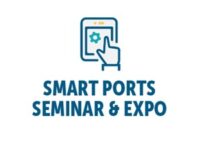Embracing the Digital Transformation Generation
Crucial Steps Are Being Made in the Exploration and Testing of Information Technology at PortsBy Sandy Smith

Derrick Whalen, director of information and technology services for the Port of Halifax, has spent just a few months on the job and in the seaports industry. But he already sees opportunities to make an impact.
“This is the challenge I was hoping it would be,” Whalen said.
Sure, there are the issues of learning a new job and industry. But Whalen comes to the port at a time when the industry is amid a digital transformation, with technologies driving additional efficiencies and providing new insights.
Whalen, who has worked in other industries that faced similar digital change, believes there are two responses for any organization: “You can be a resistor of the change or embrace the change,” he said. “From the CEO down, this organization is embracing digital transformation.”
The same could be said of the broader seaport industry as several new initiatives are underway.
Gene Seroka, executive director for the Port of Los Angeles, believes the digital transformation is a generational change. “If we can harness data with the level of ingenuity that we demonstrated on the engineering side 35 or 40 years ago when we built infrastructure, this will be regarded as a special time. This is our digital infrastructure generation.”
A NEW ERA OF MODERNIZATION
• Expanded capacity
Deepening to 40 feet
$45M in improvements
• Cutting edge
New electric hybrid crane
Port electrification
• Efficient
New laydown area
Optimal turnaround times
The Port OF Hueneme
We Make Cargo Move
Foreign Trade Zone #205
www.portofh.orghttp://www.portofh.orghttp://www.portofh.org
Blockchain at the Base
The digital infrastructure revolves significantly around blockchain, also known as distributed ledger technology. Its most prominent product at this point is bitcoin and other digital currencies. At its most foundational level, blockchain creates a list of records that are linked together. Each block contains information about the previous block, a timestamp and transaction data. It will create a “secure digital document repository for the shipping industry,” Whalen said. “You will have a ledger using common processes to share documents that are secure and verifiable. No one will be able to change the information and you can share information between partners. Blockchain is a trust platform.”
On a practical level, it means that the Port of Montréal has insight into cargo from the second it leaves a small village in India. “It provides us with tremendous business intelligence and market intelligence,” said Daniel Olivier, director business intelligence and innovation at Montréal Port Authority.
Montréal participates in TradeLens, a blockchain software platform developed by Maersk and IBM. As of mid-2019, TradeLens had more than 100 organizations throughout the supply chain: shippers, ports, terminal operators, third-party logistics and freight forwarders.
“A majority of our ocean customers are on one single platform, which provides visibility end-to-end,” Olivier said.
Todd Scott, blockchain vice president, global trade, for IBM Industry Platform, said the goal of TradeLens was to impact the inefficiencies in the supply chain. “With 90 percent of what we sit on, wear and use shipping via water, it’s still a highly inefficient system,” Scott said. “There is a lack of visibility of where goods are and there is an immense amount of documentation and human intervention in the management of that documentation.”
Scott said the company is ahead of targets in terms of implementation. “We set targets: How many ports, how many terminals, how many customs authorities will we have on the platform? Once we get those on the platform, it makes it a lot easier for beneficial cargo owners (BCOs) and inland transport. We’re in the phase now where we’re onboarding data from the carriers. We have them committed. We’re working with their data and many of the BCOs around the globe to get them to participate in the platform.”
“If we can harness data with the level of ingenuity that we demonstrated on the engineering side 35 or 40 years ago when we built infrastructure, this will be regarded as a special time. This is our digital infrastructure generation.”
—Gene Seroka, Port of Los Angeles
Olivier sees even more possibilities for TradeLens going forward. “It’s really having full end-to-end visibility over containers that will hit us and having better forecast of inbound volumes.”
Data standardization is another important benefit for ports, Olivier said.
TradeLens has proven “the mechanics of blockchain work,” said Whalen. The Port of Halifax is a participant and the beta Canadian Port in TradeLens.
“We used to say to management, ‘We need a bunch of money to implement a system.’ You get to the other side and someone’s disappointed,” Whalen said. “What happens when you take small steps, you get more agile and more learning as you go. The good thing about a software-as-a-service (SaaS) like TradeLens, you can take small steps.”
From a financial risk perspective, implementing a SaaS platform supports a lower up-front cost. Rather than buying or building an in-house technology platform, SaaS can often be treated as “a scalable operational expense item rather than a large capital expenditure,” Whalen said.
Port Optimizer™, developed by GE Transportation, a Wabtec company, works somewhat similarly. It provides insight into shipping by integrating data from across the port ecosystem. It also incorporates machine learning to help monitor dynamic conditions and proactively communicate.
TRADELENS HAS CAPABILITIES THAT PROVIDE A BILL OF LADING VALIDATOR FOR BANKS

“That helps with people having access to credit being able and to conduct trade in a more efficient manner,” said Todd Scott, IBM Blockchain vice president, global trade. The idea was driven by beneficial cargo owners who asked about getting their banks access to TradeLens. “We were so focused on making sure the goods were tracked, and properly. Now we have a way for them to receive payments and credit more easily as well,” Scott said.
The Port of Los Angeles partnered in creating Port Optimizer™, which rolled out its official first version in January. “There’s been a lot of involvement by the users and our customers in the design and development of the product. It wasn’t just something that we put out,” Seroka said. “We reverse-engineered it at the ground level.”
As the key participant in its development, the Port of Los Angeles now has “90% to 95% of the inbound cargo that moves through the Port of Los Angeles moving through Port Optimizer™. We finally have critical mass.”
As with TradeLens, while the benefits are immediate, there is more opportunity around the corner, Seroka said, particularly in “reduced trucking turn times, more accuracy with the railroads on moving assets, crews and engine power, giving visibility to what happens once the ship comes in until the cargo moves from the marine terminal.”
The Port Optimizer software is updated a couple of times per month, providing “real-time feedback,” Seroka said. “It’s about the information that already exists and trying to aggregate it down to simple reading and understanding so that stakeholders don’t have to hunt and peck for the milestones most critical to them.”
A universal truck reservation system throughout the San Pedro Bay and the ability to move chassis off terminals are the next phase, Seroka said.
Getting so many participants to share information has been a hurdle. “It’s not sinister, but you’ve got so many people that we work with every day,” Seroka said. “Getting all those folks on the same page is always going to be a challenge. We’ve got to stay in front of these stakeholders.”
For his part, Seroka believes that collaboration will improve the outlook for everyone. “Everyone has their heart in the right place, but they’ve got different commercial and operational strategies.”
Scott believes blockchain can have a much greater impact – and does not see all ports settling on one software solution. “We know there are a lot of other options out there in the industry as our clients, as ports, terminals and customs authorities are evaluating. We see a world where there will be multiple platforms. It’s our job as technology providers to make sure that a client’s data can be exchanged fairly easily if they happen to have that data created or stored on multiple platforms.”
A Single Port Solution
The Port of Antwerp is often regarded as a leader in this area and for good reason. The stakeholders at the Port of Antwerp and the Antwerp Port Authority have developed a data sharing platform designed to improve efficiencies throughout all operational layers. NxtPort unlocks the potential of sharing, combining and applying existing data among the port’s logistic players. As a result, the terminal operations and the whole logistics chain, including the intermodal connections, are more efficient and transparent, said Filip Vandenbussche, the port’s leader of business development in North America.
Vandenbussch is quick to point out that NxtPort has successfully released applications for the various port communities whether it is for the container, breakbulk, dry bulk or liquid bulk cargo. “NxtPort is a cloud-based data sharing platform, and it’s not blockchain per se,” he said. “NxtPort acts as the data custodian making sure that all the data providers can rest assured that their data is safe. Every data provider has full control over their data, and they can set the rules accordingly.”
The data sharing has provided significant efficiency gains throughout the operations. At the container terminals, fluidity challenges that are inherent with larger vessels have been improved. “The container terminal knows now well beforehand how many and which containers go on a certain barge. In the past, the scheduling of the barges was not synchronized in the best possible way, resulting in wasted time and under-optimized loads on the barge. Now intermodal connections are synchronized so that all the containers are prepositioned in sync with the barge or rail schedule.”
The efficiency gains are now tangible “and that’s what it takes to convince more supply chain service providers to join. The operational efficiency gains and the improved fluidity to the hinterland is now tangible,” Vandenbussche said.
While NxtPort currently is focused solely at the Port of Antwerp, Vandenbussche sees a day when there will be a network of trusted networks, connecting port community systems, improving the total supply chain. He does not believe there is a tremendous technical hurdle in connecting these datahubs, a perspective he brings from his days in Silicon Valley.
Blockchain is not required within a port community data sharing platform, he believes. But it may come handy when connecting data hubs across the globe. “It is an immutable way of conveying and transferring data.” Some blockchain applications are in test. The Phytosanitary Certificates follow in blockchain mode the containers of perishables from New Zealand and Australia to Antwerp. From the documentation, customs officials “can determine whether to release the cargo or inspect it further,” he said.
Global Collaborative
Building upon the knowledge one port gains in this digital transformation is vital. Los Angeles and Montréal are working to do just that through chainPORT, a consortium begun in 2016 by the Hamburg Port Authority. It is comprised of 13 member ports and the Global Institute of Logistics; Los Angeles and Montréal are currently the only North American members.
“The idea was to get a small number of ports together and see how we could help start the conversations around the supply chain,” Seroka said. “It got folks talking about digital alliances and blockchain. It really set the conversation around issues that lead it into a new age. That’s where chainPORT is going to continue to flourish, by being very respectful of individual port strategies but trying to connect at a higher level.”
SINGAPORE AIRLINES USES BLOCKCHAIN TO ALLOW ITS FREQUENT FLYERS TO CONVERT LOYALTY POINTS INTO PURCHASES

Singapore Airlines uses blockchain to allow its frequent flyers to convert loyalty points into purchases. Customers download an app and can pay at a number of participating retailers. All the frequent flier needs to do is scan a QR code.
One of the consortium’s first events was a hackathon, hosted by Los Angeles and Antwerp in October 2018. Experts in areas of mobility, interport, safety, process and document flow, sustainability and education were given specific and real problems to solve on issues like truck turn times, congestion and traffic patterns.
Through chainPORT, Montréal finds itself “the small rookie in the big leagues,” Olivier said. “The point we’re trying to make is three-fold: to innovate, you don’t need scale. We’re a river port competing against ocean ports that are three times larger. Innovation is a differentiator. In an economy that is increasingly digital, our goal is nothing short of being North America’s SmartPort.”
Ports of all sizes must be involved in digital transformation, Vandenbussche said. “It is not about small, medium or large ports. It’s about your customers, the intermodal service providers, the shipping lines and most of all, the BCOs. Sooner or later, they will ask, ‘How can we connect digitally?’”
Tech Development Closer to Home
Port of Montréal also has partnered with a local university program, CENTECH, to develop its own ideas and technologies. CENTECH is an accelerator and incubator of startups and young companies. “We’ll throw challenges and raise awareness about our industry,” Olivier said. “They’ll come up with applicable commercial solutions. If we’re satisfied, we can develop a full-blown project.”
Working with the university program, then, has Montréal in the midst of “most of these disruptive technologies,” Olivier said. “It’s not about pushing technology for the sake of it. We see technology in terms of answering a real need.”
One startup through its Centech program is working on applying machine vision to visually inspect the integrity of containers, using AI to note anomalies that require human attention. “That’s streamlining the whole truck entry process,” Olivier said.
Future-Focused
While some of the specifics may be in question, it is clear that digital transformation is just beginning. Implementing blockchain might seem a challenge on its own, but Whalen, for one, is looking “at things strategically. We have a number of initiatives underway. We want to be strategic about looking at all that’s out there.”
Data remains a big priority for the Port of Halifax to better inform decisions. “It’s not just volume. It’s quality,” Whalen said. “The more we can get the right data working for us, the more predictability and efficiency we can apply across our port and commercial operations.”
Any future digital investments need to be “aligned effectively with our internal strategic plan as well as the needs for our port customer,” Whalen said.
Scott sees a future where several emerging technologies come together, notably the internet of things, which is a “perfect fit for blockchain. The data that is being collected for IoT can be very useful for blockchain,” he said. He points to insurance rates that BCOs pay. “What if that insurance provider had access to data, which is generally public information, but they don’t have a way to collect and centralize it? They may find that these three carriers using those three trucking companies, for the inland transport portion of the movement of cargo, don’t tend to have any claims. Therefore, the rates that are charged may be lower.”
While the potential is certainly there, Seroka – a former shipping line executive – believes North American ports are running a few paces behind their international counterparts. “I worked overseas for 12 years. I got to see this firsthand. We as a country have to accelerate the level of competitiveness, digitization and supply chain optimization.”
Ultimately, data sharing and supply chain transparency applications will continue to grow Vandenbussche believes, because BCOs “will be knocking at the door, demanding it.”
“AAPA is bringing the right message,” Vandenbussche said. “They realize the U.S. cannot miss this boat.”
Through blockchain and a number of ongoing projects, it seems that the race is on to catch up in this increasingly competitive area.
NESTLE SA IS TESTING BLOCKCHAIN TO TRACK THE FRUITS AND VEGETABLES THAT GO INTO ITS GERBER BABY PRODUCTS

Nestle SA is testing blockchain to track the fruits and vegetables that go into its Gerber baby products. According to the Wall Street Journal, Nestle and nine other large food companies are on a blockchain system called Food Trust to trace ingredients worldwide. The hope is to speed up recalls and investigations of tainted food, making it more accurate and less expensive.



